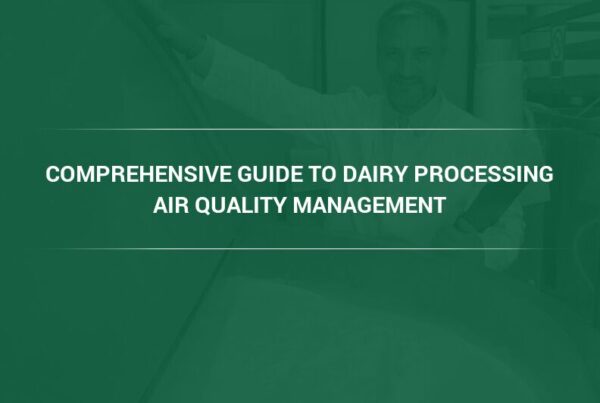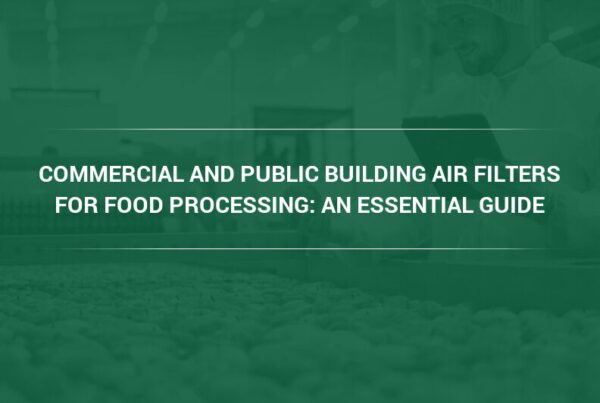Intelligent use of commercial air filters and industrial air filtration units at food preparation facilities can help protect our food from dangerous microbes.
Air pollution can affect our health in a variety of ways. Breathing in toxic air pollutants can cause a variety of health problems. Air pollutants can also harm the environment, contributing to global warming. One aspect of air pollution that isn’t frequently addressed is how the air pollution caused by biological air pollutants can threaten the safety of our food. If food is prepared in the same area as microbes, the food can become contaminated and cause a number of different health problems when consumed by a person.
Production facilities must use commercial air filters and industrial air filtration HVAC units to ensure that the levels of microbes in food preparation areas are as low as possible. How are commercial air filters and filtration units utilized in a food processing plants to reduce levels of microbes, and what policies should be followed to maximize their utility and effectiveness?
Bioaerosols Are Trapped by Industrial Air Filtration Units
It’s important to use industrial air filtration units within food preparation facilities to reduce overall levels of bioaerosols. Bioaerosols are solid or liquid particles that carry microbes through the air. Bacteria can often ride on particles of dirt or dust, getting into food or drink when it is being prepared.
“Common bioaerosols can include viruses and certain bacteria like Brucella, Listeria, and E. coli,” says Mark Davidson, Food & Beverage Segment Manager at Camfil USA. “When source areas of these bioaerosols are disturbed, the particles are propelled into the air, where they can remain suspended for long periods of time. Eventually, they will settle on to surfaces, and if the food is prepared on the surfaces, the food can become contaminated by harmful and potentially deadly pathogens.” (1)
Sources of bioaerosols within preparation facilities may include compressed air lines that are unfiltered, poorly installed or managed HVAC systems, and employee traffic that can help transport sources of bioaerosols, such as standing water.
In addition to microorganisms like E. coli and Salmonella, various molds and yeasts are common within bioaerosols. Mold and yeast can often end up as the dominant form of contamination in an area where conditions may not be conducive to common bacterial growth, such as foods that contain high amounts of salts or drinks with high amounts of alcohol.
Commercial Air Filtration Systems Prevent Diseases from Spreading
There are a variety of negative health effects associated with exposure to food contaminated with bioaerosols. Exposure to bioaerosols can cause health problems associated with the bacteria. Bioaerosols can transport infectious diseases, respiratory diseases, and can even increase the risk for cancer. Asthma and chronic obstructive pulmonary disease are examples of the respiratory diseases caused by bioaerosols. Commercial air filtration systems can trap and neutralize these harmful air pollutants.
Exposure to bacteria like E. coli and Listeria can cause problems digesting food and even kidney failure. Ingesting food contaminated with mold can even increase the risk of cancer development , due to the exposure to mycotoxins in the mold.
Exposure to Salmonella, E. coli, and Listeria all cause their respective associated diseases. Bacterial-based foodborne illnesses are usually only contracted by ingesting the contaminated food, though exposure to vomit from another contaminated person can cause illness as well. Common symptoms of infection from foodborne illnesses include diarrhea, vomiting, chills and abdominal pain.
Exposure to the bacteria called Clostridium botulinum is especially dangerous because it causes the illness known as botulism. Botulism can quickly lead to blurred vision, paralysis, and dizziness, and can be fatal in relatively short periods of time. For these reasons, it is extremely important that potential sources of botulism are cleaned up immediately.
The health effects associated with exposure to foodborne illnesses and diseases can harm everyone, but children, the elderly, and pregnant women are at special risk for harm if they are exposed to food contaminated with bioaerosols.
Maintaining the Efficiency of Industrial Air Filtration And Ventilation
Industrial air filtration and ventilation is one way to protect food from being contaminated with bioaerosols. Food processing facilities should have HVAC systems optimally placed to keep levels of bioaerosols as low as possible. Proper high efficiency air filters should be employed within these systems to capture bioaerosols and prevent them from circulating throughout the facility. Outside ventilation air can also reduce the overall concentrations of air pollutants, including bioaerosols within the building.
“It’s not enough to simply have HVAC systems and filters installed, they must be properly maintained. HVAC systems should be checked for the presence of water in drip trays,” says Camfil USA’s Mark Davidson. “Evaporative condensers and cooling coils can have water buildup on them as well, and standing water is one of the primary sources of bioaerosols. Air filters for both compressed air and intake ventilation air should be examined for any clogging or other problems like perforation, and changed as recommended by your filtration professional.” (2)
Ventilation systems should also function to optimize pressure through the building, and the more hygienic an area must be the higher the pressure of that area has to be as well. Airflow should start in the areas which are the cleanest, like packaging and storage, and move towards less clean areas like the receiving area until they are naturally exhausted from the building.
Selecting The Correct Commercial HVAC Air Filters for Use in Food Processing Facilities
The correct type of commercial HVAC air filter must be employed to capture the harmful airborne contaminants that threaten to contaminate food. Commercial air filters are rated with a system called MERV, or Minimum Efficiency Reporting Value. The higher a filter’s MERV is, the more particles it is capable of capturing.
“MERV levels of 13 or 14, or above are sufficient for capturing bioaerosols within a food processing facility, though the exact filter needs will fluctuate depending on the type of food processing facility in question,” says Davidson. “If filters are used in a fresh-cut processing facility, because of the high probability of contaminant transfer, they must be performing at the level of efficiency recommended by cognizant authorities.” (3)
When researching filters, one should check to make sure that the testing conditions used to present the filter’s performance values are conducted in near real-life conditions. If the filters were not tested under conditions that simulate real world, they may drastically drop in efficiency over time and lose the ability to protect the facility. Facilities should always make sure that their filters have a MERV-A equivalent to the filter’s MERV so performance is assured throughout the life of the filter.
Strategies Beyond The Use of Commercial Air Purifiers
While having commercial air purifiers and commercial air filters is important for the safety of food in a food processing facility, other strategies must be applied to reduce levels of microbial indoor air pollution. Source control strategies and employee training is also important for the safety of our food.
Source control means identifying and controlling potential sources of microbial contamination. The environment of the facility should be checked for any standing water in areas like restrooms, ceilings, and walls around pipes or cooling units. Processing tools and aids should be cleaned regularly to ensure there is no contamination of food. Food contact surfaces should be cleaned with the appropriate cleaning solutions as frequently as possible.
Employees at a food processing facility can easily carry microbial pathogens on or inside their bodies. Food protection practices cover both general cleanliness and disease control. Disease control means ensuring that workers with potentially contagious, foodborne illnesses are kept away from the food production line. Employees should also be trained on proper cleanliness procedures, such as the appropriate way to wash their hands and instructed in how to report possible sources of microbial contamination.
Camfil USA can provide you with the commercial air filters that will trap microbes and protect your food. Click here to contact Camfil USA today.
Sources:



